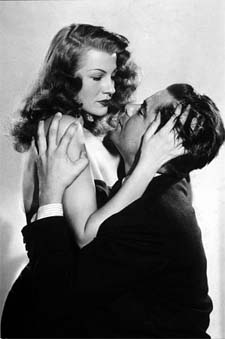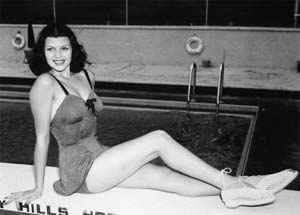
|
Rita Premieres on Turner Classic Movies Tuesday, September 9th at 8 PM (EST) Followed by a festival of Rita Hayworth films Check listings for film times Internet: http://www.turnerclassicmovies.com
The Hugh Hefner-produced special (narrated by Kim Basinger) features comment from her family members, friends and costars, including daughter (Princess) Yasmin Aga Khan, costar Anthony Fransciosa and former husband James Hill (from a previously unseen 1984 interview), and follows her career from her start as a dancer with The Dancing Cansinos during the depression, to her early beginnings as an actress wannabe in the 1930s, her stardom in the 40s and 50s and her decline and disease in the 60s and 70s. In Rita, we learn how Hayworth was, in private, a "kind, soft-spoken woman". The studios, instead, publicized her differently. "I think the publicity is always on the side of Gilda", says Anthony Fransciosa. "I think that the studios were insisting on keeping up the images - they would always correlate the image of what was on the screen to what happened in real life, and typically there was a conflict between the two."
That was not all. In order to make her look more "American", the studio's heads also worked to give her a visual makeover. "She used to have very black hair", says friend Ann Miller, "and they lightened it. And she had kind of a low hairline. They had to take about an inch out of her hair with electrolysis to give her a higher kind of a forehead, but that was very painful." After several movie roles, Rita finally reached stardom in Blood And Sand, a remake of the 1918 Valentino movie in which she played Doņa Sol, the femme fatale that leads the bullfighter to a disgraceful demise. What made her a sex symbol, however, was the famous Life Magazine pin-up. "Every soldier remembers vividly the picture of Rita on the bed in her negligee, says actor Eli Wallach, a soldier at the time. "that was the magnet for men to want to go back home." Rita divorced her first husband in 1942 after she fell in love and got engaged to Victor Mature, her costar in My Gal Sal. But as Mature headed to World War II, Orson Welles began to romance her and ultimately won her over. They married on September 7th, 1943 in a quiet ceremony during a break in the shooting of Covergirl, a musical with Gene Kelly. At the peak of her stardom, Rita got pregnant (studio chief Harry Cohen was furious at her for that), and Rebecca Wells was born on December 17th, 1944. She was reportedly happy as her dreams had come true: she had a family and apparent security, but sadly things were not in Rita's favor. Her marriage quickly went sour as Welles' workaholic and philandering tendencies took the best of their relationship. They separated in 1945. During that time, she was working on Gilda, the movie that would forever cement her sensual image. To her surprise, the public expected her to be her character, something she was not only unable, but also unwilling to do. "Hollywood has a tendency to latch onto what is current", says friend and costar Tab Hunter, "without much feeling." Rita, however, fought to keep her personal life private, so she rarely spoke to the press - especially gossip columnists Noelle Parsons and Hedda Hopper. "All I know it is that it's important to try to protect the sanctity of your privacy", comments Nicole Kidman, "because if you don't - you're so exposed as an actor to the world that if everything is exposed, it can become too much, too overwhelming."
Although separated from Orson Welles, Rita used her star image to press studio chief Larry Cohen to back The Lady From Shanghai (1948). At that time, Welles had been practically blacklisted by Hollywood for the flak he got from Citizen Kane. She was his costar, but the film ultimately didn't work with the public. As one critic put it, The Lady From Shanghai was "an experiment on what not to do." Today, however, both films are considered cult classics. After wrapping the film, Orson Welles and Rita Hayworth's marriage was finally over. During a vacation in Europe, Rita met playboy Prince Ali Khan, who Rita described as "fabulous". They fell in love, and after untangling their legal statuses, they married, and Rita left Hollywood to become Princess Margarita Ali Khan. Unfortunately, his jet-set lifestyle was too much for the quiet-loving Hayworth. "Ali Khan loved parties, he lived for parties", says Ann Miller. "he was a playboy. Knowing Rita, she would want some time at home, but she wouldn't have that from him." Rita kept trying to lead a happy life, and she was very joyful when her second child, Princess Yasmin Aga Khan was born in December 1949. Even though Khan was a good father for both of Rita's children, the never-ending lack of privacy was too much for her, and she finally returned to America after two years of marriage. "It didn't work out as a marriage", says her daughter, Princess Yasmin, "but their friendship remained - and their love for each other remained." She returned home to her career as a single mom, although she wasn't exactly happy about it. Affair in Trinidad (1952), a mediocre film in retrospect, was her comeback vehicle, but despite the bad script, she threw herself into the role, and her dance scenes are nothing but memorable. During the making of Salome, she met nightclub singer Dick Haymes, who she ultimately married. Later Rita would say she only married him to help him out with his troubles with the IRS and to stop his deportation to Argentina. Once again it didn't work, due to the various troubles that are described in the documentary. "Haymes manipulated her into all sorts of unpleasant situations", says Bob Schiffer, a longtime friend and makeup artist. "I witnessed all of these and it bothered me too because I was so friendly with her. I guess I was the only one who didn't want anything from her. We just had fun. While she was married to these fellows, she began to realize that everyone was having dinner on her." Rita filed for divorce in 1955, and after four years without making any movies, she had her second comeback in a dramatic role in Fire Down Below (1957). The same year, she co-starred with Frank Sinatra in Pal Joey, which would be her final film with Columbia studios. Her next role was in Separate Tables, a film co-produced by her final husband(whom she married in 1958), James Hill. In that role, she plays(alongside Burt Lancaster) an "aging, once beautiful lady, and her essential problem(in the words of director Delbert Mann) is her desperate fear of growing old - particularly of growing old alone". The marriage with Hill didn't work. As with Orson Welles in the forties, Hill was a workaholic, and he saw in his relationship with Hayworth and opportunity to make movies, while Rita longed for some quiet time. They divorced in the fall of 1961. After coming to terms with living alone and spending time with her family, she slowly began to show the symptoms of the illness that would claim her life. Rita was losing her short-term memory, and she was having various mood swings and moments of odd behavior that were augmented with her growing alcoholism, which had been fueled out of her frustration of not being able to remember her lines. "She was giggly, she was this loving mother, but then again there was this other side to her that was the disease side", says daughter Yasmin Aga Khan." I saw early, during the years that she suffered with alcoholism and the Alzheimer's slowly creeping in - the alcohol exacerbated the Alzheimer's and it slowly became this huge illness. She was slowly just losing her mind." She continued to pursue movie roles during the 1960s and 70s, but her illness made her unable to memorize her lines. She had to use cue cards by the end of her career. "She looked shy and unhappy", says Eli Wallach, "she'd do her work on the set and then wander off and no one knew where she was." Her last film was The Wrath of God (1972), opposite Robert Mitchum. After various manic episodes of erratic behavior that many attributed to her drinking, she was finally diagnosed with Alzheimer's disease in a Los Angeles hospital. It was a sad, sad ending", says Bob Schiffer. "She was at The Hope Memorial Hospital, apparently she wasn't recognizing people. I sat in the room with her, and her eyes had that distant look, she was off someplace, and I'd bring up some of the situations that we were involved in, what we did and the laughs we had, and then suddenly she would come out of it, and this wonderful face would blossom with the recognition of good times - like she was a little girl again." Rita Hayworth died in New York on May 14th, 1987 after spending her last days bedridden and unable to walk, talk or take care of herself - indeed a sad ending for a woman who, during her lifetime had inspired so many for decades with her selfless dance and gracious moves. Her memory, though, lives on, and we have her films, which continue to impress us and shall continue to do so for years to come. |
|
 Sex symbol Rita Hayworth
Sex symbol Rita Hayworth Rita Hayworth and Glenn Ford in Gilda
Rita Hayworth and Glenn Ford in Gilda During the filming of Down To Earth Rita,
understanding her leverage as a star, started her own
production company with the objective of taking
control of her own career. "Rita always did what was
right to herself", says Ann Miller. "She was a very
smart woman. She had an inner strength of her own and
she stood up for herself when it came to her rights."
During the filming of Down To Earth Rita,
understanding her leverage as a star, started her own
production company with the objective of taking
control of her own career. "Rita always did what was
right to herself", says Ann Miller. "She was a very
smart woman. She had an inner strength of her own and
she stood up for herself when it came to her rights."